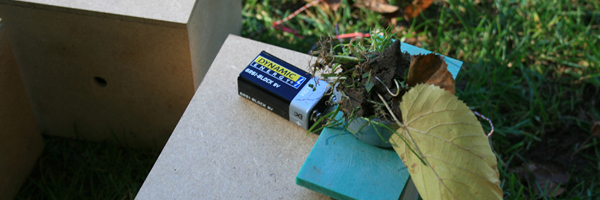5. October 2010
 1. Insights
Through utilizing "Analog Prototypes" it was possible for me to proof first theoretical and conceptional assumptions. Also this prototypes were very good to get insights about how children interact with objects, how they approach them how they integrate them into their play. Besides the conceptional findings which could be applied to the design of the later interactive cubes it was interesting for me to learn more about the social interaction that took place during my observation and the childrens play with the cubes.
1.1 Conceptual findings
How the children react to the objects is depending on their appearance or "Gestalt". Although all of the cubes have the same dimensions and were all made of the same material they differentiated slightly in their visual appearance because of functional reasons. These differences (e.g. the crank or the hole to look inside the cube) were main factors how quick the functionality was detected by the children. In this way, the "Touch" object was one of the first to be detected by the children.
1.2. Social interactions
Besides the childrens activity with the cubes themselves it was very interesting to see in which ways the children influenced themselves in their play. At the beginning of the observation Jan (5 years) made the first step to explore the objects. The other kids were looking at this time from the distant at the objects. As they realized that Jan was playing already with the cubes, they quickly joined him and searched their own object to explore. The minutes after the children were looking at each other to see, what the other ones have just discovered. In this way they become more courageous to try the objects themselves. Later on the children start to communicate their ideas and they were thinking collectively about things they could do with the cubes. Very enhancing for social interaction has been the "Look Through" and the "Feel Movement" cube. At the end of my observation this cube was completely disassembled by the kids to get the motor, which was inside. With this motor they were trying to build a ventilator.
3.3. Theoretical findings
Children in this age are able to identify hidden features and functionalities of objects even if they are not perceptible at first sight. Also they are able to think about creative solutions what to do with this objects. In the process of approaching and exploring the objects they act often as a group.
4. Further steps
To test what happens if the cubes become interactive it will be necessary to provide this interactivity. As a next step I will build a pair of two interactive cubes which are able to communicate amongst each other and which have embedded input and feedback. Questions for this steps will be, if the children can imagine a interaction or gesture to indicate a connection between the cubes and what will happen, when they realize that those cubes have the possibility to communicate.
1. Insights
Through utilizing "Analog Prototypes" it was possible for me to proof first theoretical and conceptional assumptions. Also this prototypes were very good to get insights about how children interact with objects, how they approach them how they integrate them into their play. Besides the conceptional findings which could be applied to the design of the later interactive cubes it was interesting for me to learn more about the social interaction that took place during my observation and the childrens play with the cubes.
1.1 Conceptual findings
How the children react to the objects is depending on their appearance or "Gestalt". Although all of the cubes have the same dimensions and were all made of the same material they differentiated slightly in their visual appearance because of functional reasons. These differences (e.g. the crank or the hole to look inside the cube) were main factors how quick the functionality was detected by the children. In this way, the "Touch" object was one of the first to be detected by the children.
1.2. Social interactions
Besides the childrens activity with the cubes themselves it was very interesting to see in which ways the children influenced themselves in their play. At the beginning of the observation Jan (5 years) made the first step to explore the objects. The other kids were looking at this time from the distant at the objects. As they realized that Jan was playing already with the cubes, they quickly joined him and searched their own object to explore. The minutes after the children were looking at each other to see, what the other ones have just discovered. In this way they become more courageous to try the objects themselves. Later on the children start to communicate their ideas and they were thinking collectively about things they could do with the cubes. Very enhancing for social interaction has been the "Look Through" and the "Feel Movement" cube. At the end of my observation this cube was completely disassembled by the kids to get the motor, which was inside. With this motor they were trying to build a ventilator.
3.3. Theoretical findings
Children in this age are able to identify hidden features and functionalities of objects even if they are not perceptible at first sight. Also they are able to think about creative solutions what to do with this objects. In the process of approaching and exploring the objects they act often as a group.
4. Further steps
To test what happens if the cubes become interactive it will be necessary to provide this interactivity. As a next step I will build a pair of two interactive cubes which are able to communicate amongst each other and which have embedded input and feedback. Questions for this steps will be, if the children can imagine a interaction or gesture to indicate a connection between the cubes and what will happen, when they realize that those cubes have the possibility to communicate.